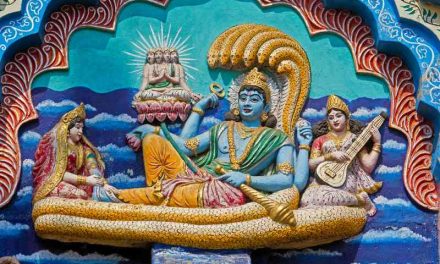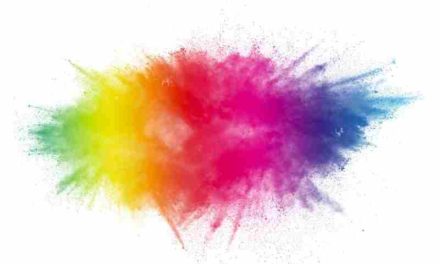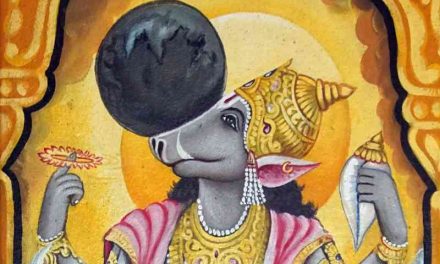Among the Sanskrit terms for “martial art” are dhanurveda (from dhanus “bow” and veda “knowledge,” literally “science of archery” in Puranic literature, later applied to martial arts in general),
A true warrior who had a complete understanding of Dhanurveda was regarded as invincible. Even in deep sleep, they would be perfectly vigilant and fully aware on the battlefield, and they would be fighting simply for the greatest goal with no connection to the result of the conflict. They were established in existence at the same time as they were doing the activity. Their superiority on the battlefield was unquestionable.
During my undergraduate studies in India in the 1980s, I was invited to do a thesis on Dhanurveda, the Veda of physical, mental, emotional, and spiritual development, which I completed in the 1990s.
Based on my thesis, I named my very first audio-cassette course Invincible Athletics – in which I sought to apply these ideas to the field of athletic performance – and dubbed it Invincible Athletics. This seminar served as a forerunner to my first book on sports, Body, Mind, and Sport. The book incorporated research that we undertook to demonstrate the concepts of Dhanurvedic medicine.
Astravidya (from vidya “learning, knowledge,” and astra “sword, weapon,” literally “knowledge of the sword,” and astravidya (from vidya “learning, knowledge).
The Vishnu Purana literature mentions dhanurveda as one of the traditional eighteen divisions of “applied knowledge,” also known as upaveda, which is defined as “knowledge that is applied.” In the north, the ancient form of wrestling is known as mallayuddha, while in the south, it is known as malyutham.
Diffrerent types of Martial arts
A few of the most popular martial arts disciplines performed in modern India include Kalaripayattu in Kerala, Southern India (which is an umbrella name for several armed as well as unarmed styles), and Pehlwani wrestling in Northern India. Thang-ta, which originated in Manipur, and gatka, which originated in the Punjab area, are two notable regional styles.
Indian epics feature descriptions of battles, including those with heroes such as Bhima. The Mahabharata portrays lengthy combat between Arjuna and Karna, in which they use bows, swords, trees, boulders, and fists to defeat each other.
The Mahabharata has a description of another unarmed combat in which two warriors box with their closed fists and fight with kicks, fists, finger strikes, knee strikes, and headbutts In the 3rd century, components from Patanjali’s Yoga Sutras, as well as finger gestures from nata dances, were introduced into martial arts practice.
In Southern India, the first written evidence of martial arts goes back to the Tamil Sangam literature, which was written between the 2nd century BC and the 2nd century AD. When it comes to the Sangam age, the Akananuru and Purananuru provide detailed descriptions of the employment of spears, swords, shields, arrows, and silambam.
A battleground or fighting arena is described by the term Kalari in the Puram (verses 225, 237, 245, 356) and Akam (verses 34, 231, 293) as well as in other scriptures. The term Kalari tatt represented a martial achievement, but the term Kalari kozhai denoted a coward in battle.
Everyone who fought in the Sangam period underwent regular military training, which included target practice and horse riding skills. It was common for them to specialize in one or more significant weapons of the time.
Such as the vel (lance or spear), Val (sword), kedaham (shield), and Vil Ambu (spear) (bow and arrow). The fighting methods used during the Sangam era were the first examples of what would become known as kalarippayattu.
The term kalari first appears in Sangam literature, dating back to the 2nd century BC. Among the martial arts of ancient Tamilakkam that the Akananuru and Purananuru describe are many types of close combat, the use of spears, swords, shields, bows, and silambam, as well as the use of shields and bows.
Several times throughout the Puram and Akam, the term “kalari” is used to refer to both the battlefield and a fighting arena. “Silappadikkaram” appears in Sangam literature as early as the 2nd century, according to certain sources. This was a reference to the silambam workers, who were in high demand among international tourists.
Treatises on martial arts, like other fields of Sanskrit literature, grow increasingly systematic during the course of the first millennium AD. Vajra Mushti is a grappling technique that has been referenced in literature dating back to the first century CE. During the Gupta Empire’s reign (c. 240-480), Indian military sources recorded approximately 130 distinct types of weaponry.
The Kama Sutra, authored by Vtsyyana, advised women to “exercise with sword, single-stick, quarterstaff, and bow and arrow” on a regular basis, as well as with other weapons. Chandra, kundalini, chakra, and mantra are all major metaphysical notions that were established around this period by tantric thinkers.
There are 107 essential places on the human body identified in the Sushruta Samhita (about the 4th century), with 64 of them being considered fatal if struck with a fist or a stick in the correct manner.
As a result of Sushruta’s work, the medical discipline known as Ayurveda developed, which was taught alongside a variety of Indian martial arts, particularly those that placed a focus on key points such as Varma Kalai, among others.
Due to a smattering of additional allusions to critical locations in Vedic and epic literature, it is very probable that India’s early warriors were familiar with and practiced assaulting or defending vital spots. A group of granite sculptures depicting unarmed soldiers defeating armed opponents was commissioned by King Narasimhavarman, of the Pallava dynasty, around the year 630 AD.
There is a possibility that they depicted an early version of Varma adi, a Dravidian martial art that permitted kicking and kneeing to the head and chest, as well as elbowing and striking, but forbade strikes below the waist. This is a style that is similar to that described in the Agni Purana.
The Kshatriya caste was not the only one that practiced martial arts, but the warrior class tended to do it more often.
Fighting techniques were taught at ghatika and salad educational institutions in the 8th century, where non-ksatria students from all over the subcontinent (particularly from South India, Rajasthan, and Bengal) “were learning and practicing archery, fighting with sword and shield, with daggers, sticks, lances, and with fists, and in duels (niuddham),” according to the 8th century text Kuvalaymala by Udyotanasuri
The Agni Purana (which is believed to have been written between the eighth and eleventh centuries) contains the first existing handbook of dhanurveda.
The dhanurveda part of the Agni Purana includes chapters 248-251.
It separates the art into Four sections, which are as follows:
- yantra-mukta is a term used to describe a person who has achieved enlightenment (projectile weapons such as the sling or the bow),
- pi-mukta is a kind of pi-mukta (hurling weapons such as the javelin),
- mukta-sandharita or mukta-mukta is a kind of mukta (weapons that can be used for either hurling or thrusting, such as the spear),
- hasta-astra (also known as amukta) (melee weapons that do not leave the hand, such as the sword),
While the duel with a bow and arrows is regarded as the noblest or masculine type of combat, fighting with a spear is considered the second most noble or manly form of fighting.
Fighting with a sword is considered unmanly, while wrestling is considered the meanest or worst kind of fighting. Only a Brahmin could be an acharya (teacher) of dhanurveda, and Kshatriyas and Vaishyas were expected to study from Brahmin instructors in order to maintain the tradition.
There are nine asanas, or fighting postures, that are described here.
- Standing in tight rows with the feet together is referred to as samapada, which means “keeping the feet even” (248.9)
- vaikha, which means “standing up straight with your feet apart” (248.10)
- maala “disk,” organized in the form of a flock of geese while standing with the knees apart (248.11)
- lha “licked, polished,” performed by bending the right knee while pulling the left foot back (248.12)
- pratylha, which involves bending the left knee while pulling the right foot back (248.13)
- jta “origin,” in which the right foot is placed straight with the left foot perpendicular, and the ankles are spaced five fingers apart, is performed (248.14)
- dayata “stretched staff,” in which the right knee is bent while the left leg is straight, or vice versa; this is referred to as vikaa “dreadful” if the two legs are two palm-lengths apart (248.16)
- sampua “hemisphere” is a Greek word that means “hemisphere” (248.17)
- svastika, which means “well-being,” with the feet 16 fingers apart and the feet lifted a little bit (248.19)
After that, there is a more in-depth review of the archery technique.
The section concludes with a list of the names of actions or “deeds” that can be performed with a variety of weapons, including 32 positions to be taken with a sword and shield (khagacarmavidhau), 11 names of techniques for using a rope in fighting, as well as 5 names of “acts in the rope operation,” as well as lists of “deeds” pertaining to the chakra, the spear, the tomara or iron club, the gaa or mace, the





